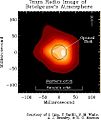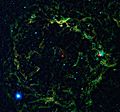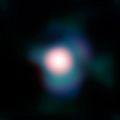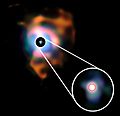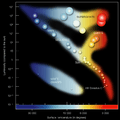Betelgeuse facts for kids
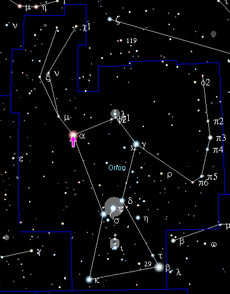
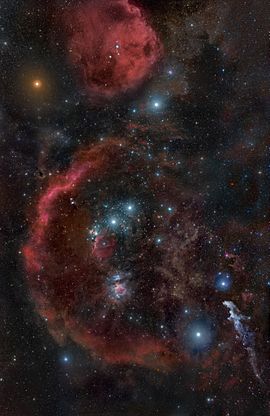
Betelgeuse (from Arabic:إبط الجوزاء Ibṭ al-Jauzā’, meaning "the armpit of Orion") is a large red supergiant star in the Orion constellation. It is usually the ninth-brightest star in the night sky and the second-brightest in Orion.
Betelgeuse is a semiregular variable star whose apparent magnitude varies between 0.2 and 1.2. This is the widest range for the brightness of any first-magnitude star.
It is also one of the largest and most luminous stars seen from Earth. Its radius is between 950 to 1,000 times wider than the Sun. This means it is 0.821 to 0.865 billion miles (1.322 to 1.392 billion kilometers) in diameter. Betelgeuse was the first star other than the Sun whose size was known. The star's distance from Earth is about 640 light-years. Its average absolute magnitude is about −6.02.
It is moving through the interstellar medium at a speed of 18.6 mi/s (30 km/s), creating a shock wave over 4 light-years wide. The Herschel Space Observatory observed in January 2013 that the star's winds were crashing against the small objects in space. Betelgeuse is one of the red supergiant stars to have a bow shock (shock waves in the shape of a bow). Others are Mu Cephei and IRC-10414.
Betelgeuse evolves rapidly because of its high mass. It is now in a later stage of stellar evolution. It will quickly go through its life cycle before exploding as a type II supernova.
Betelgeuse can be seen at the upper left in Orion, as his shoulder.
Interesting facts about Betelgeuse
- Betelgeuse is about 7,500 to 14,000 times brighter than the Sun.
- If we replaced our Sun with Betelgeuse, it would stretch past Jupiter's orbit.
- Betelgeuse has a surface temperature of about 6,000 degrees Fahrenheit (over 3,300 degrees Celsius), about 4,000 degrees cooler than the Sun.
- In 1836, astronomer and mathematician Sir John Herschel documented Betelgeuse's changing brightness.
- Betelgeuse suddenly became fainter for several months during late 2019 and early 2020. By April 2020, it had returned to its natural brightness.
- Betelgeuse is the first star to have its photosphere measured.
Alternate names
Betelgeuse is also called Alpha Orionis (α Orionis, abbreviated Alpha Ori, α Ori).
Related pages
- Orion (constellation)
- Rigel
- 119 Tauri, Antares, and Mu Cephei, other similar red supergiant stars
Images for kids
-
Sir John Herschel in 1846
-
1998/9 UV HST images of Betelgeuse showing asymmetrical pulsations with corresponding spectral line profiles
-
AAVSO V-band magnitude of Betelgeuse, between September 2018 and February 2021
-
NRAO's Very Large Array used to derive Betelgeuse's 2008 distance estimate
-
AAVSO V-band light curve of Betelgeuse (Alpha Orionis) from Dec 1988 to Aug 2002
-
Infrared image of Betelgeuse, Meissa, and Bellatrix with surrounding nebulae
-
Size comparison of Betelgeuse, Mu Cephei, KY Cygni, and V354 Cephei, according to Emily Levesque
-
Image from ESO's Very Large Telescope showing the stellar disk and an extended atmosphere with a previously unknown plume of surrounding gas
-
Exterior view of ESO's Very Large Telescope (VLT) in Paranal, Chile
-
Nebula and Betelgeuse: the tiny red circle]] in the middle is the size of the photosphere.
-
Hertzsprung–Russell diagram identifying supergiants like Betelgeuse that have moved off the main sequence
-
An illustration of Orion (horizontally reversed) in al-Sufi's Book of Fixed Stars. Betelgeuze is annotated as Yad al-Jauzā ("Hand of Orion"), one of the proposed etymological origins of its modern name, and also as Mankib al Jauzā' ("Shoulder of Orion").
See also
 In Spanish: Betelgeuse para niños
In Spanish: Betelgeuse para niños








